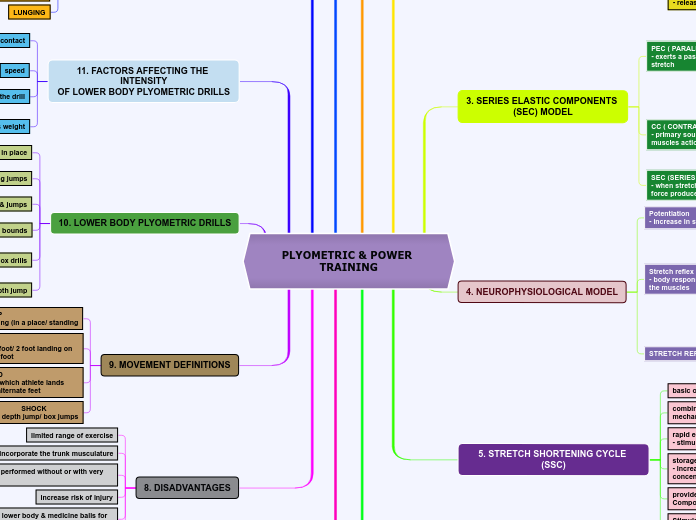PLYOMETRIC & POWER TRAINING
1. DEFINITION
Acceleration & deceleration to create quick, powerful movement through pre-stretch/ countermovement involving the Stretch Shortening Cycle (SSC)
increase the power of subsequent movements by using both the natural elastic components of muscle & tendon and the stretch reflex.
2. MECHANICAL MODEL OF PLYOMETRIC EXERCISE
elastic energy in the musculotendinous
- increase with rapid stretch & store
movement immediately followed by
concentric muscle action, stored elastic energy (EE)
- released to increase the total force production.
3. SERIES ELASTIC COMPONENTS
(SEC) MODEL
PEC ( PARALLEL ELASTIC COMPONENT)
- exerts a passive force with unstimulated muscle stretch
epimysium
perimysium
endomysium
sarcolemma
CC ( CONTRACTILE COMPONENT)
- primary source of muscle force during concentric
muscles action
actin
myosin
cross-bridges
SEC (SERIES ELASTIC COMPONENT)
- when stretched, store energy elastic increased force produced.
4. NEUROPHYSIOLOGICAL MODEL
Potentiation
- increase in strength impulse
change in force-velocity of muscle
contraction caused by stretch reflex
Stretch reflex
- body response to external stimulus that stretches the muscles
muscle spindle
quick stretch
(muscles increase reflexively)
Plyometric
(reflexive muscle action when muscle spindle
stimulated by rapid stretch)
STRETCH REFLEX
muscle spindle > muscle stretch stimulated > travel to spinal cord via nerve fiber > synapsing with alpha motor neuron in spinal cord > travel to agonist extrafusal fibers > reflexive muscle action
5. STRETCH SHORTENING CYCLE (SSC)
basic of plyometric eercise
combination of mechanical & neurophysiological mechanism
rapid eccentric muscle action
- stimulates stretch reflex
storage of elastic energy
- increase the force produced during the next concentric action
provide energy storage of Series Elastic Components (SEC)
Stimulation of stretch reflex to facilitate a maximal increase in muscle over a minimal time
6. PHASES OF SSC
I. Eccentric phase ( stretch of agonist muscle)
- elastic store in SEC ' muscle spindle stimulated'
II. Amortization phase ( pause between phase I & II)
- afferent nerve synapse alpha neuron motor
- alpha motor neuron transmit signal to agonist muscle group
III. Concentric phase (shortening of agonist muscle)
- elastic energy release from SEC
- alpha motor neuron stimulate agonist muscle group
13. IMPLEMENTING A PLYOMETRIC PROGRAM
evaluate the athletes
equipment & facilities provide safe environment
establish sport specific goals
determine program design variables
teach the athlete proper technique
properly progress the program
12. PLYOMETRIC WARM-UP DRILLS
MARCHING
JOGING
SKIPPING
FOOTWORK
LUNGING
11. FACTORS AFFECTING THE INTENSITY
OF LOWER BODY PLYOMETRIC DRILLS
points of contact
the grand reaction force during single leg lower body, plyometric drills places more stress on muscle, tissue and joints
speed
greater speed increase the intensity of the drill
height of the drill
the higher body's center of gravity, the greater force on the landing
participant's weight
the greater the athlete weight, the more stress is placed on the msucles
10. LOWER BODY PLYOMETRIC DRILLS
jumps in place
jump and land in the same spot
standing jumps
emphasize either horizontal or vertical components
multiple hops & jumps
Involve repeated movements
bounds
exaggerated movements with greater horizontal speed
box drills
increase the intensity of multiple hops and jumps by using box
depth jump
use gravity for athlete weight to increase exercise intensity
9. MOVEMENT DEFINITIONS
JUMP
- concludes with 2 foot landing (in a place/ standing
HOP
- Starts & concludes with 1 foot/ 2 foot landing on the same foot
BOUND
- series of movements in which athlete lands successively on alternate feet
SHOCK
- In depth jump/ box jumps
8. DISADVANTAGES
limited range of exercise
difficult to incorporate the trunk musculature
exercise generally performed without or with very limited feedback
increase risk of injury
use body mass for lower body & medicine balls for upper body
time constraints with exercise progression
7. ADVANTAGES
production of high forces and acceleration throughout full ROM
Requires athlete to rapidly develop force
performed in a more explosive way than speed
training and traditional weight
adopted in most sporting actions
performed exercise at higher velocities vs. traditional weight training.
promoting the development of muscular power
no deceleration phase
